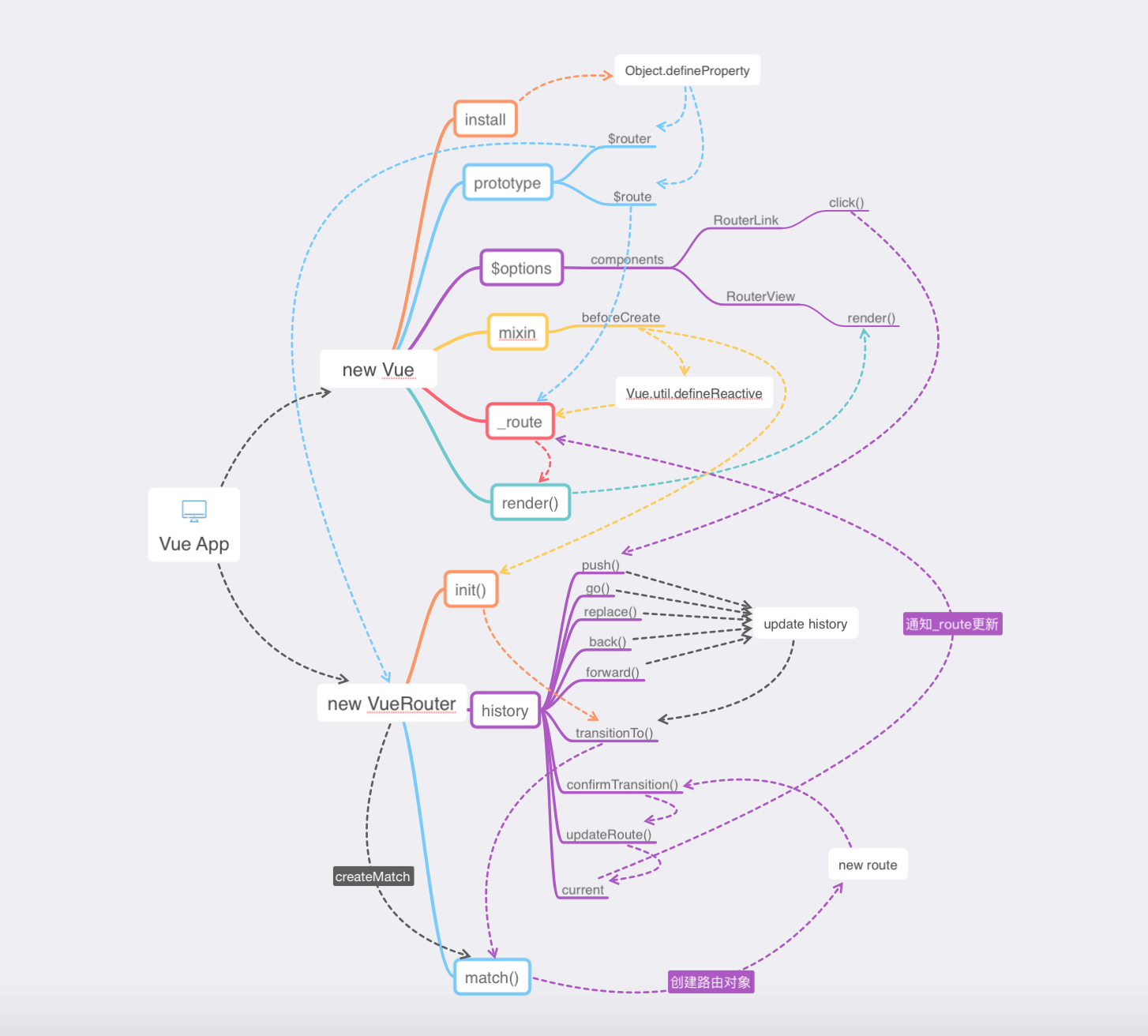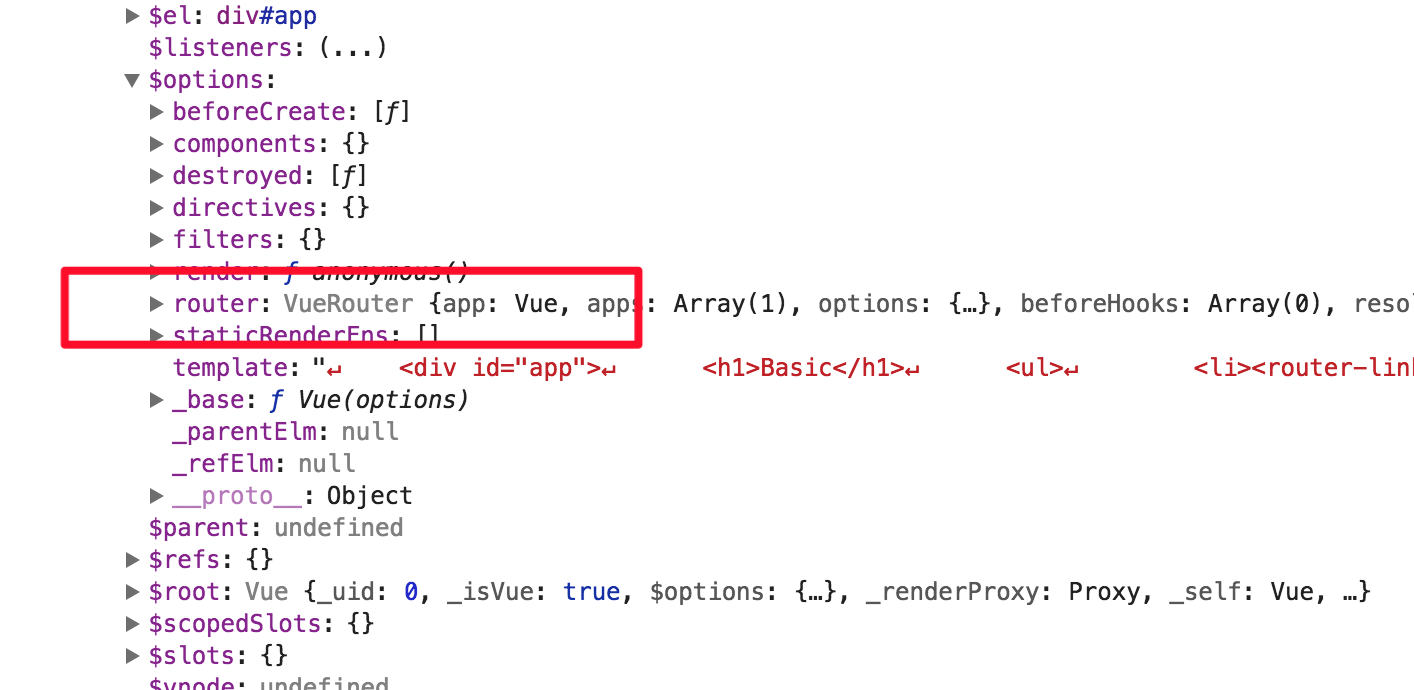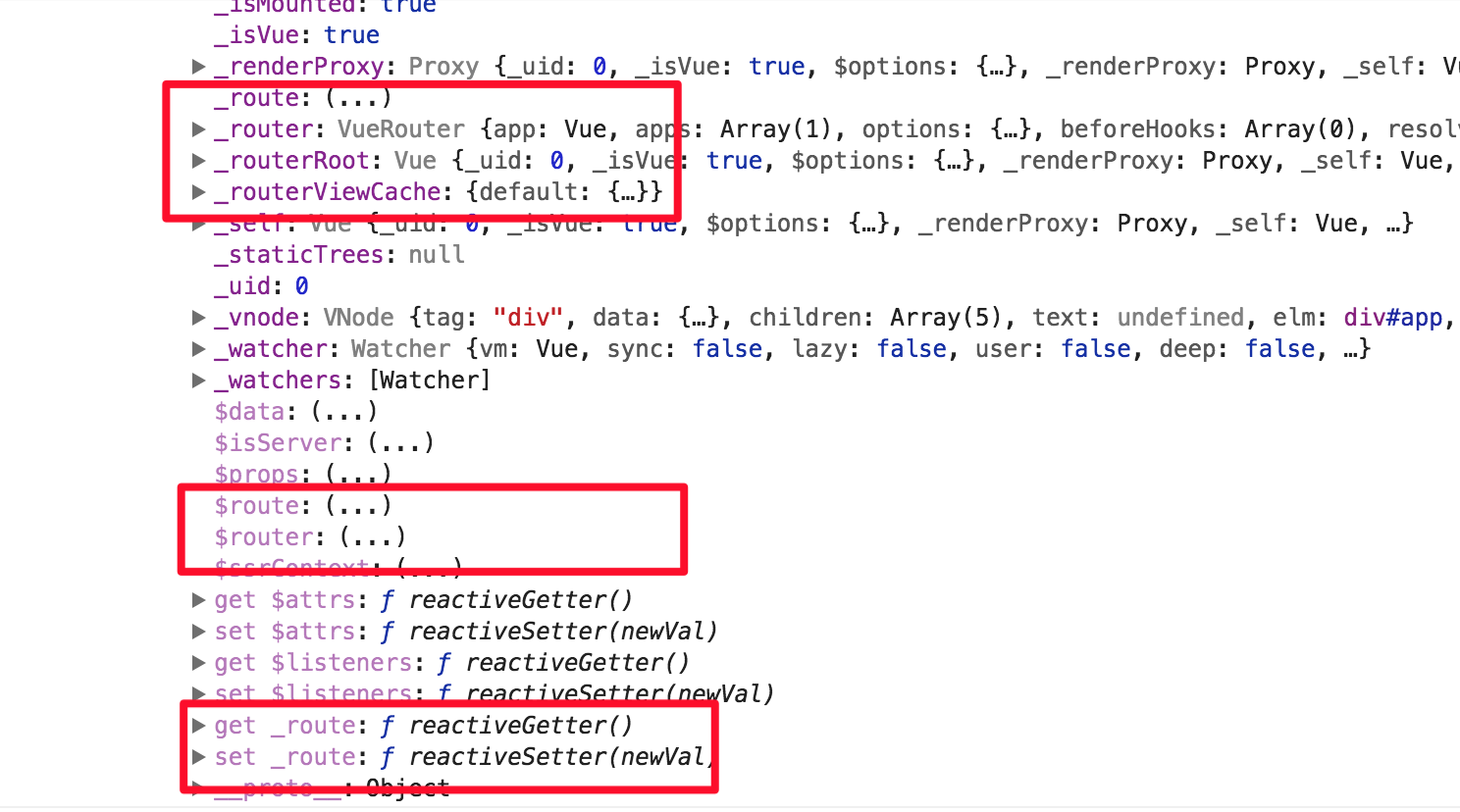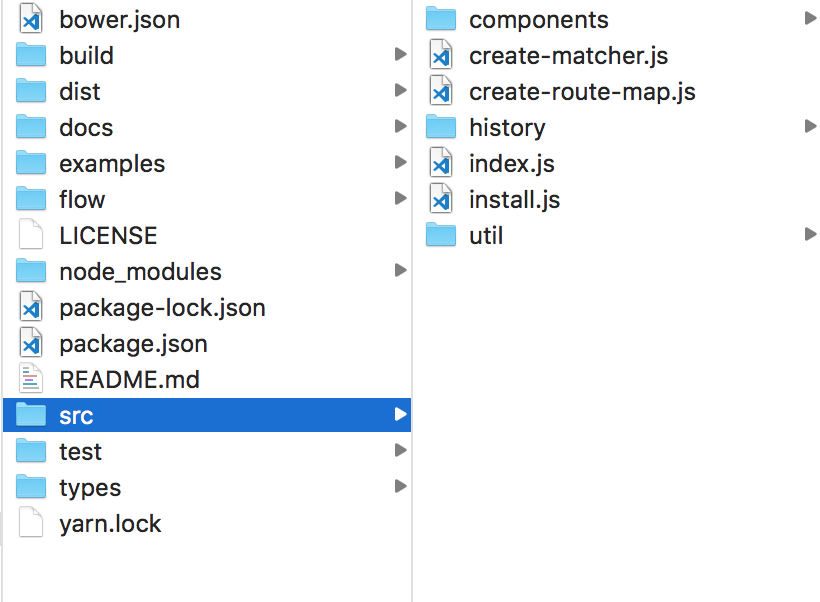前几天笔者看到一个问题:你真的了解vue-router的吗?你知道vue-router的运行原理吗?抱着这样的问题,笔者开始了vue-router的源码探索之旅。本文并没有逐行去深究源码,而是跟着笔者画的流程图来简析每一步的运行流程。
剖析运行流程
笔者根据源码的结构和自己的理解事先画好了一张流程图,乍一看这张运行流程图可能会有点蒙圈,笔者接下来会现根据这张图分析下运行流程,然后再一步一步的剖析源码的核心部分。



- $options下的
router对象很好理解,这个就是我们在实例化Vue的时候挂载的那个vue-router实例; _route是一个响应式的路由route对象,这个对象会存储我们路由信息,它是通过Vue提供的Vue.util.defineReactive来实现响应式的,下面的get和set便是对它进行的数据劫持;_router存储的就是我们从$options中拿到的vue-router对象;_routerRoot指向我们的Vue根节点;_routerViewCache是我们对View的缓存;$route和$router是定义在Vue.prototype上的两个getter。前者指向_routerRoot下的_route,后者指向_routerRoot下的_router
接下来让我们顺顺这个“眼花缭乱的图”,以便于我们后面更好的理解之后的源码分析。
首先我们根据Vue的插件机制安装了vue-router,这里其实做的很简单,总结起来就是封装了一个mixin,定义了两个'原型',注册了两个组件。在这个mixin中,beforeCreate钩子被调用然后判断vue-router是否实例话了并初始化路由相关逻辑,前文提到的_routerRoot、_router、_route便是在此时被定义的。定义了两个“原型”是指在Vue.prototype上定一个两个getter,也就$route和$router。注册了两个组件是指在这里注册了我们后续会用到的RouterView和RouterLink这两个组件。
然后我们创建了一个VueRouter的实例,并将它挂载在Vue的实例上,这时候VueRouter的实例中的constructor初始化了各种钩子队列;初始化了matcher用于做我们的路由匹配逻辑并创建路由对象;初始化了history来执行过渡逻辑并执行钩子队列。
接下里mixin中beforeCreate做的另一件事就是执行了我们VueRouter实例的init()方法执行初始化,这一套流程和我们点击RouteLink或者函数式控制路由的流程类似,这里我就一起说了。在init方法中调用了history对象的transitionTo方法,然后去通过match获取当前路由匹配的数据并创建了一个新的路由对象route,接下来拿着这个route对象去执行confirmTransition方法去执行钩子队列中的事件,最后通过updateRoute更新存储当前路由数据的对象current,指向我们刚才创建的路由对象route。
最开始的时候我们说过_route被定义成了响应式的 那么一个路由更新之后,_route对象会接收到响应并通知RouteView去更新视图。
到此,流程就结束了,接下来我们将深入vue-router的源码去深度学习其原理。
剖析源码
说在前面
vue-router的源码都采用了flow作为类型检验,没有配置flow的话可能会满屏报错,本文不对flow做过多的介绍了。为了便于大家的理解,下面的源码部分我会将flow相关的语法去掉。顺便附上一些flow相关:
flow官方文档(需要科学上网):https://flow.org/ flow入门:https://zhuanlan.zhihu.com/p/26204569 flow配置:https://zhuanlan.zhihu.com/p/24649359
项目结构
在拿到一个项目的源码时候,我们首先要去看它的目录结构:

- componets是RouterLink和RouterView这两个组件;
- create-matcher.js就是我们创建match的入口文件;
- create-route-map.js用于创建path列表,path map,name map等;
- history是创建hitory类的逻辑;
- index.js就是我们的入口文件,其中创建了VueRouter这个类;
- install.js是我们挂载vue-router插件的逻辑;
- util定义了很多工具函数;
应用入口
通常我们去构建一个Vue应用程序的时候入口文件通常会这么写:
// app.js
import Vue from 'vue';
import VueRouter from 'vue-router';
import Main from '../components/main';
Vue.use(VueRouter);
const router = new VueRouter({
routes: [{
path: '/',
component: Main,
}],
});
// app.js
new Vue({
router,
template,
}).$mount('#app')
我们可以看到vue-router是以插件的形式安装的,并且vue-router的实例也会挂载在Vue的实例上面。
插件安装
此时我们将目光移入源码的入口文件,发现index.js中引入了install模块,并在VueRouter类上挂载了一个静态的install方法。而且还判断了环境中如果已经挂载了Vue则自动去使用这个插件。
源码位置:/src/index.js
import { install } from './install'
import { inBrowser } from './util/dom'
// ...
export default class VueRouter {}
// ...
// 挂载install;
VueRouter.install = install
// 判断如果window上挂载了Vue则自动使用插件;
if (inBrowser && window.Vue) {
window.Vue.use(VueRouter)
}
接下来看install.js这个文件,这个文件导出了export方法以供Vue.use去安装:
源码位置:/src/install.js
import View from './components/view'
import Link from './components/link'
// export一个Vue的原因是可以不讲Vue打包进插件中而使用Vue一些方法;
// 只能在install之后才会存在这个Vue的实例;
export let _Vue
export function install (Vue) {
// 如果插件已经安装就return
if (install.installed && _Vue === Vue) return
install.installed = true
_Vue = Vue
const isDef = v => v !== undefined
const registerInstance = (vm, callVal) => {
let i = vm.$options._parentVnode
if (isDef(i) && isDef(i = i.data) && isDef(i = i.registerRouteInstance)) {
i(vm, callVal)
}
}
Vue.mixin({
beforeCreate () {
// this.$options.router为VueRouter实例;
// 这里判断实例是否已经挂载;
if (isDef(this.$options.router)) {
// 将router的根组件指向Vue实例
this._routerRoot = this
this._router = this.$options.router
// router初始化,调用VueRouter的init方法;
this._router.init(this)
// 使用Vue的defineReactive增加_route的响应式对象
Vue.util.defineReactive(this, '_route', this._router.history.current)
} else {
// 将每一个组件的_routerRoot都指向根Vue实例;
this._routerRoot = (this.$parent && this.$parent._routerRoot) || this
}
// 注册VueComponent 进行Observer处理;
registerInstance(this, this)
},
destroyed () {
// 注销VueComponent
registerInstance(this)
}
})
// 为$router和4route定义 << getter >> 分别指向_routerRoot的 _router 和 _route
// _router 为VueRouter的实例;
// _route 为一个存储了路由数据的对象;
Object.defineProperty(Vue.prototype, '$router', {
get () { return this._routerRoot._router }
})
Object.defineProperty(Vue.prototype, '$route', {
get () { return this._routerRoot._route }
})
// 注册组件
Vue.component('RouterView', View)
Vue.component('RouterLink', Link)
// Vue钩子合并策略
const strats = Vue.config.optionMergeStrategies
// use the same hook merging strategy for route hooks
strats.beforeRouteEnter = strats.beforeRouteLeave = strats.beforeRouteUpdate = strats.created
}
这里需要注意的几点:
- 导出一个Vue引用:这是为了不用将整个Vue打包进去就可以使用Vue提供的一些API,当然,这些的前提就是vue-router必须被安装挂载;
- 在Vue.prototype上定义两个getter:Vue的组件都是Vue实例的一个扩展,他们都可以访问prototype上的方法和属性;
- 定义响应式_route对象:有了这个响应式的路由对象,就可以在路由更新的时候及时的通知RouterView去更新组件了;
实例化VueRouter
接下来我们来看VueRouter类的实例化,在constructor中主要做的就两件事,创建matcher和创建history:
源码位置:/src/index.js
// ...
import { createMatcher } from './create-matcher'
import { supportsPushState } from './util/push-state'
import { HashHistory } from './history/hash'
import { HTML5History } from './history/html5'
import { AbstractHistory } from './history/abstract'
// ...
export default class VueRouter {
constructor (options) {
this.app = null
this.apps = []
// VueRouter 配置项;
this.options = options
// 三个钩子
this.beforeHooks = []
this.resolveHooks = []
this.afterHooks = []
// 创建路由匹配实例;传人我们定义的routes:包含path和component的对象;
this.matcher = createMatcher(options.routes || [], this)
// 判断模式
let mode = options.mode || 'hash'
// 判断浏览器是否支持history,如果不支持则回退到hash模式;
this.fallback = mode === 'history' && !supportsPushState && options.fallback !== false
if (this.fallback) {
mode = 'hash'
}
// node运行环境 mode = 'abstract';
if (!inBrowser) {
mode = 'abstract'
}
this.mode = mode
// 根据模式创建对应的history实例
switch (mode) {
case 'history':
this.history = new HTML5History(this, options.base)
break
case 'hash':
this.history = new HashHistory(this, options.base, this.fallback)
break
case 'abstract':
this.history = new AbstractHistory(this, options.base)
break
default:
if (process.env.NODE_ENV !== 'production') {
assert(false, `invalid mode: ${mode}`)
}
}
}
// ...
}
创建matcher
顺着思路我们先看createMatcher这个函数:
import VueRouter from './index'
import { resolvePath } from './util/path'
import { assert, warn } from './util/warn'
import { createRoute } from './util/route'
import { fillParams } from './util/params'
import { createRouteMap } from './create-route-map'
import { normalizeLocation } from './util/location'
// routes为我们初始化VueRouter的路由配置;
// router就是我们的VueRouter实例;
export function createMatcher (routes, router) {
// pathList是根据routes生成的path数组;
// pathMap是根据path的名称生成的map;
// 如果我们在路由配置上定义了name,那么就会有这么一个name的Map;
const { pathList, pathMap, nameMap } = createRouteMap(routes)
// 根据新的routes生成路由;
function addRoutes (routes) {
createRouteMap(routes, pathList, pathMap, nameMap)
}
// 路由匹配函数;
function match (raw, currentRoute, redirectedFrom) {
// 简单讲就是拿出我们path params query等等;
const location = normalizeLocation(raw, currentRoute, false, router)
const { name } = location
if (name) {
// 如果有name的话,就去name map中去找到这条路由记录;
const record = nameMap[name]
if (process.env.NODE_ENV !== 'production') {
warn(record, `Route with name '${name}' does not exist`)
}
// 如果没有这条路由记录就去创建一条路由对象;
if (!record) return _createRoute(null, location)
const paramNames = record.regex.keys
.filter(key => !key.optional)
.map(key => key.name)
if (typeof location.params !== 'object') {
location.params = {}
}
if (currentRoute && typeof currentRoute.params === 'object') {
for (const key in currentRoute.params) {
if (!(key in location.params) && paramNames.indexOf(key) > -1) {
location.params[key] = currentRoute.params[key]
}
}
}
if (record) {
location.path = fillParams(record.path, location.params, `named route "${name}"`)
return _createRoute(record, location, redirectedFrom)
}
} else if (location.path) {
location.params = {}
for (let i = 0; i < pathList.length; i++) {
const path = pathList[i]
const record = pathMap[path]
// 根据当前路径进行路由匹配
// 如果匹配就创建一条路由对象;
if (matchRoute(record.regex, location.path, location.params)) {
return _createRoute(record, location, redirectedFrom)
}
}
}
// no match
return _createRoute(null, location)
}
// ...
function _createRoute (record, location, redirectedFrom) {
// 根据不同的条件去创建路由对象;
if (record && record.redirect) {
return redirect(record, redirectedFrom || location)
}
if (record && record.matchAs) {
return alias(record, location, record.matchAs)
}
return createRoute(record, location, redirectedFrom, router)
}
return {
match,
addRoutes
}
}
function matchRoute (regex, path, params) {
const m = path.match(regex)
if (!m) {
return false
} else if (!params) {
return true
}
for (let i = 1, len = m.length; i < len; ++i) {
const key = regex.keys[i - 1]
const val = typeof m[i] === 'string' ? decodeURIComponent(m[i]) : m[i]
if (key) {
params[key.name] = val
}
}
return true
}
function resolveRecordPath (path, record) {
return resolvePath(path, record.parent ? record.parent.path : '/', true)
}
首先createMatcher会根据我们初始化VueRouter实例时候定义的routes配置,通过createRouteMap生成一份含有对应关系的map,具体逻辑下面我们会说到。然后返回一个包含match和addRoutes两个方法的对象match,就是我们实现路由匹配的详细逻辑,他会返回匹配的路由对象;addRoutes会就是添加路由的方法。
接下来我们顺着刚才的思路去看create-route-map.js
/* @flow */
import Regexp from 'path-to-regexp'
import { cleanPath } from './util/path'
import { assert, warn } from './util/warn'
export function createRouteMap (routes, oldPathList, oldPathMap, oldNameMap) {
// the path list is used to control path matching priority
const pathList = oldPathList || []
// $flow-disable-line
const pathMap = oldPathMap || Object.create(null)
// $flow-disable-line
const nameMap = oldNameMap || Object.create(null)
// path列表
// path的map映射
// name的map映射
// 为配置的路由项增加路由记录
routes.forEach(route => {
addRouteRecord(pathList, pathMap, nameMap, route)
})
// ensure wildcard routes are always at the end
for (let i = 0, l = pathList.length; i < l; i++) {
if (pathList[i] === '*') {
pathList.push(pathList.splice(i, 1)[0])
l--
i--
}
}
// 返回包含path数组,path map和name map的对象;
return {
pathList,
pathMap,
nameMap
}
}
function addRouteRecord (pathList, pathMap, nameMap, route, parent, matchAs) {
const { path, name } = route
if (process.env.NODE_ENV !== 'production') {
assert(path != null, `"path" is required in a route configuration.`)
assert(
typeof route.component !== 'string',
`route config "component" for path: ${String(path || name)} cannot be a ` +
`string id. Use an actual component instead.`
)
}
// 定义 path 到 Reg 的选项;
const pathToRegexpOptions: PathToRegexpOptions = route.pathToRegexpOptions || {}
// 序列化path,'/'将会被替换成'';
const normalizedPath = normalizePath(
path,
parent,
pathToRegexpOptions.strict
)
// 正则匹配是否区分大小写;
if (typeof route.caseSensitive === 'boolean') {
pathToRegexpOptions.sensitive = route.caseSensitive
}
const record = {
path: normalizedPath,
regex: compileRouteRegex(normalizedPath, pathToRegexpOptions),
components: route.components || { default: route.component },
instances: {},
name,
parent,
matchAs,
redirect: route.redirect,
beforeEnter: route.beforeEnter,
meta: route.meta || {},
props: route.props == null
? {}
: route.components
? route.props
: { default: route.props }
}
// 如果有嵌套的子路由,则递归添加路由记录;
if (route.children) {
// Warn if route is named, does not redirect and has a default child route.
// If users navigate to this route by name, the default child will
// not be rendered (GH Issue #629)
if (process.env.NODE_ENV !== 'production') {
if (route.name && !route.redirect && route.children.some(child => /^\/?$/.test(child.path))) {
warn(
false,
`Named Route '${route.name}' has a default child route. ` +
`When navigating to this named route (:to="{name: '${route.name}'"), ` +
`the default child route will not be rendered. Remove the name from ` +
`this route and use the name of the default child route for named ` +
`links instead.`
)
}
}
route.children.forEach(child => {
const childMatchAs = matchAs
? cleanPath(`${matchAs}/${child.path}`)
: undefined
addRouteRecord(pathList, pathMap, nameMap, child, record, childMatchAs)
})
}
// 如果路由含有别名,则为其添加别名路由记录
// 关于alias
// https://router.vuejs.org/zh-cn/essentials/redirect-and-alias.html
if (route.alias !== undefined) {
const aliases = Array.isArray(route.alias)
? route.alias
: [route.alias]
aliases.forEach(alias => {
const aliasRoute = {
path: alias,
children: route.children
}
addRouteRecord(
pathList,
pathMap,
nameMap,
aliasRoute,
parent,
record.path || '/' // matchAs
)
})
}
// 更新path map
if (!pathMap[record.path]) {
pathList.push(record.path)
pathMap[record.path] = record
}
// 为定义了name的路由更新 name map
if (name) {
if (!nameMap[name]) {
nameMap[name] = record
} else if (process.env.NODE_ENV !== 'production' && !matchAs) {
warn(
false,
`Duplicate named routes definition: ` +
`{ name: "${name}", path: "${record.path}" }`
)
}
}
}
function compileRouteRegex (path, pathToRegexpOptions) {
const regex = Regexp(path, [], pathToRegexpOptions)
if (process.env.NODE_ENV !== 'production') {
const keys: any = Object.create(null)
regex.keys.forEach(key => {
warn(!keys[key.name], `Duplicate param keys in route with path: "${path}"`)
keys[key.name] = true
})
}
return regex
}
function normalizePath (path, parent, strict): string {
if (!strict) path = path.replace(/\/$/, '')
if (path[0] === '/') return path
if (parent == null) return path
return cleanPath(`${parent.path}/${path}`)
}
从上述代码可以看出,create-route-map.js的就是根据用户的routes配置的path、alias以及name来生成对应的路由记录。
创建history
matcher这一部分算是讲完了,接下来该说History的实例化了,从源码来说history文件夹下是有4个文件的,base作为基类,另外三个继承这个基类来分别处理vue-router的各种mode情况,这里我们主要看base的逻辑就可以了。
// install 到处的Vue,避免Vue打包进项目增加体积;
import { START, isSameRoute } from '../util/route'
export class History {
constructor (router, base) {
this.router = router
this.base = normalizeBase(base)
// start with a route object that stands for "nowhere"
// 生成一个基础的route对象;
this.current = START
this.pending = null
this.ready = false
this.readyCbs = []
this.readyErrorCbs = []
this.errorCbs = []
}
// ...
}
// ...
function normalizeBase (base: ?string): string {
if (!base) {
if (inBrowser) {
// respect <base> tag
const baseEl = document.querySelector('base')
base = (baseEl && baseEl.getAttribute('href')) || '/'
// strip full URL origin
base = base.replace(/^https?:\/\/[^\/]+/, '')
} else {
base = '/'
}
}
// make sure there's the starting slash
if (base.charAt(0) !== '/') {
base = '/' + base
}
// remove trailing slash
return base.replace(/\/$/, '')
}
基础的挂载和各种实例化都说完了之后,我们可以从init入手去看之后的流程了。

源码位置:/src/index.js
// ...
init (app) {
process.env.NODE_ENV !== 'production' && assert(
install.installed,
`not installed. Make sure to call \`Vue.use(VueRouter)\` ` +
`before creating root instance.`
)
// 从install中的调用我们知道,这个app就是我们实例化的vVue实例;
this.apps.push(app)
// main app already initialized.
if (this.app) {
return
}
// 将VueRouter内的app指向我们亘Vue实例;
this.app = app
const history = this.history
// 针对于 HTML5History 和 HashHistory 特殊处理,
// 因为在这两种模式下才有可能存在进入时候的不是默认页,
// 需要根据当前浏览器地址栏里的 path 或者 hash 来激活对应的路由
if (history instanceof HTML5History) {
history.transitionTo(history.getCurrentLocation())
} else if (history instanceof HashHistory) {
const setupHashListener = () => {
history.setupListeners()
}
history.transitionTo(
history.getCurrentLocation(),
setupHashListener,
setupHashListener
)
}
//...
}
// ...
可以看到初始化主要就是给app赋值,并且针对于HTML5History和HashHistory进行特殊的处理,因为在这两种模式下才有可能存在进入时候的不是默认页,需要根据当前浏览器地址栏里的path或者hash来激活对应的路由,此时就是通过调用transitionTo来达到目的;
接下来来看看这个具体的transitionTo:
源码位置:/src/history/base.js
transitionTo (location, onComplete, onAbort) {
// localtion为我们当前页面的路由;
// 调用VueRouter的match方法获取匹配的路由对象,创建下一个状态的路由对象;
// this.current是我们保存的当前状态的路由对象;
const route = this.router.match(location, this.current)
this.confirmTransition(route, () => {
// 更新当前的route对象;
this.updateRoute(route)
onComplete && onComplete(route)
// 调用子类的方法更新url
this.ensureURL()
// fire ready cbs once
// 调用成功后的ready的回调函数;
if (!this.ready) {
this.ready = true
this.readyCbs.forEach(cb => { cb(route) })
}
}, err => {
if (onAbort) {
onAbort(err)
}
// 调用失败的err回调函数;
if (err && !this.ready) {
this.ready = true
this.readyErrorCbs.forEach(cb => { cb(err) })
}
})
}
confirmTransition (route, onComplete, onAbort) {
const current = this.current
const abort = err => {
if (isError(err)) {
if (this.errorCbs.length) {
this.errorCbs.forEach(cb => { cb(err) })
} else {
warn(false, 'uncaught error during route navigation:')
console.error(err)
}
}
onAbort && onAbort(err)
}
// 如果是同一个路由就不去跳转;
if (
isSameRoute(route, current) &&
// in the case the route map has been dynamically appended to
route.matched.length === current.matched.length
) {
// 调用子类的方法更新url
this.ensureURL()
return abort()
}
// 交叉比对当前路由的路由记录和现在的这个路由的路由记录
// 以便能准确得到父子路由更新的情况下可以确切的知道
// 哪些组件需要更新 哪些不需要更新
const {
updated,
deactivated,
activated
} = resolveQueue(this.current.matched, route.matched)
// 注意,matched里头存储的是路由记录的数组;
// // 整个切换周期的队列,待执行的各种钩子更新队列
const queue: Array<?NavigationGuard> = [].concat(
// in-component leave guards
// 提取组件的 beforeRouteLeave 钩子
extractLeaveGuards(deactivated),
// global before hooks
this.router.beforeHooks,
// in-component update hooks
// 提取组件的 beforeRouteUpdate 钩子
extractUpdateHooks(updated),
// in-config enter guards
activated.map(m => m.beforeEnter),
// async components
// 异步处理组件
resolveAsyncComponents(activated)
)
// 保存下一个状态的路由
this.pending = route
// 每一个队列执行的 iterator 函数
const iterator = (hook: NavigationGuard, next) => {
if (this.pending !== route) {
return abort()
}
try {
hook(route, current, (to: any) => {
if (to === false || isError(to)) {
// next(false) -> abort navigation, ensure current URL
this.ensureURL(true)
abort(to)
} else if (
typeof to === 'string' ||
(typeof to === 'object' && (
typeof to.path === 'string' ||
typeof to.name === 'string'
))
) {
// next('/') or next({ path: '/' }) -> redirect
abort()
if (typeof to === 'object' && to.replace) {
this.replace(to)
} else {
this.push(to)
}
} else {
// confirm transition and pass on the value
next(to)
}
})
} catch (e) {
abort(e)
}
}
// 执行各种钩子队列
runQueue(queue, iterator, () => {
const postEnterCbs = []
const isValid = () => this.current === route
// wait until async components are resolved before
// extracting in-component enter guards
// 等待异步组件 OK 时,执行组件内的钩子
const enterGuards = extractEnterGuards(activated, postEnterCbs, isValid)
const queue = enterGuards.concat(this.router.resolveHooks)
// 在上次的队列执行完成后再执行组件内的钩子
// 因为需要等异步组件以及是OK的情况下才能执行
runQueue(queue, iterator, () => {
if (this.pending !== route) {
return abort()
}
// 路由过渡完成
this.pending = null
onComplete(route)
if (this.router.app) {
this.router.app.$nextTick(() => {
postEnterCbs.forEach(cb => { cb() })
})
}
})
})
}
updateRoute (route) {
const prev = this.current
// 将current指向我们更新后的route对象;
this.current = route
this.cb && this.cb(route)
this.router.afterHooks.forEach(hook => {
hook && hook(route, prev)
})
}
逻辑看似复杂,实际上就是各种钩子函数的来回处理,但是这里要注意下,每一个路由route对象都会有一个matchd属性,这个属性包含一个路由记录,这个记录的生成在create-matcher.js中已经提到了。
等一下,我们好像漏了点东西,init后面还有一点没说:
源码位置:/src/index.js
// 设置路由改变时候的监听;
history.listen(route => {
this.apps.forEach((app) => {
app._route = route
})
})
在这里设置了route改变之后的回调函数, 会在confirmTransition中的onComplete回调中调用, 并更新当前的_route的值,前面我们提到,_route是响应式的,那么当其更新的时候就会去通知组件重新render渲染。
两个组件
大体流程都看完了,接下来可以看看两个组件了,我们先看RouterView组件: 源码位置:/src/components/view.js
import { warn } from '../util/warn'
export default {
name: 'RouterView',
functional: true,
props: {
// 试图名称,默认是default
name: {
type: String,
default: 'default'
}
},
render (_, { props, children, parent, data }) {
data.routerView = true
// directly use parent context's createElement() function
// so that components rendered by router-view can resolve named slots
// 渲染函数
const h = parent.$createElement
const name = props.name
// 拿到_route对象和缓存对象;
const route = parent.$route
const cache = parent._routerViewCache || (parent._routerViewCache = {})
// determine current view depth, also check to see if the tree
// has been toggled inactive but kept-alive.
// 组件层级
// 当 _routerRoot 指向 Vue 实例时就终止循环
let depth = 0
let inactive = false
while (parent && parent._routerRoot !== parent) {
if (parent.$vnode && parent.$vnode.data.routerView) {
depth++
}
// 处理 keep-alive 组件
if (parent._inactive) {
inactive = true
}
parent = parent.$parent
}
data.routerViewDepth = depth
// render previous view if the tree is inactive and kept-alive
// 渲染缓存的 keep-alive 组件
if (inactive) {
return h(cache[name], data, children)
}
const matched = route.matched[depth]
// render empty node if no matched route
if (!matched) {
cache[name] = null
return h()
}
const component = cache[name] = matched.components[name]
// attach instance registration hook
// this will be called in the instance's injected lifecycle hooks
// 添加注册钩子, 钩子会被注入到组件的生命周期钩子中
// 在 src/install.js, 会在 beforeCreate 钩子中调用
data.registerRouteInstance = (vm, val) => {
// val could be undefined for unregistration
const current = matched.instances[name]
if (
(val && current !== vm) ||
(!val && current === vm)
) {
matched.instances[name] = val
}
}
// also register instance in prepatch hook
// in case the same component instance is reused across different routes
;(data.hook || (data.hook = {})).prepatch = (_, vnode) => {
matched.instances[name] = vnode.componentInstance
}
// resolve props
let propsToPass = data.props = resolveProps(route, matched.props && matched.props[name])
if (propsToPass) {
// clone to prevent mutation
propsToPass = data.props = extend({}, propsToPass)
// pass non-declared props as attrs
const attrs = data.attrs = data.attrs || {}
for (const key in propsToPass) {
if (!component.props || !(key in component.props)) {
attrs[key] = propsToPass[key]
delete propsToPass[key]
}
}
}
return h(component, data, children)
}
}
function resolveProps (route, config) {
switch (typeof config) {
case 'undefined':
return
case 'object':
return config
case 'function':
return config(route)
case 'boolean':
return config ? route.params : undefined
default:
if (process.env.NODE_ENV !== 'production') {
warn(
false,
`props in "${route.path}" is a ${typeof config}, ` +
`expecting an object, function or boolean.`
)
}
}
}
function extend (to, from) {
for (const key in from) {
to[key] = from[key]
}
return to
}
然后是RouterLink组件:
/* @flow */
import { createRoute, isSameRoute, isIncludedRoute } from '../util/route'
import { _Vue } from '../install'
// work around weird flow bug
const toTypes: Array<Function> = [String, Object]
const eventTypes: Array<Function> = [String, Array]
export default {
name: 'RouterLink',
props: {
to: {
type: toTypes,
required: true
},
tag: {
type: String,
default: 'a'
},
exact: Boolean,
append: Boolean,
replace: Boolean,
activeClass: String,
exactActiveClass: String,
event: {
type: eventTypes,
default: 'click'
}
},
render (h: Function) {
// 获取挂载的VueRouter实例
const router = this.$router
// 获取当前的路由对象
const current = this.$route
// 获取当前匹配的路由信息
const { location, route, href } = router.resolve(this.to, current, this.append)
const classes = {}
const globalActiveClass = router.options.linkActiveClass
const globalExactActiveClass = router.options.linkExactActiveClass
// Support global empty active class
const activeClassFallback = globalActiveClass == null
? 'router-link-active'
: globalActiveClass
const exactActiveClassFallback = globalExactActiveClass == null
? 'router-link-exact-active'
: globalExactActiveClass
const activeClass = this.activeClass == null
? activeClassFallback
: this.activeClass
const exactActiveClass = this.exactActiveClass == null
? exactActiveClassFallback
: this.exactActiveClass
const compareTarget = location.path
? createRoute(null, location, null, router)
: route
classes[exactActiveClass] = isSameRoute(current, compareTarget)
classes[activeClass] = this.exact
? classes[exactActiveClass]
: isIncludedRoute(current, compareTarget)
const handler = e => {
if (guardEvent(e)) {
if (this.replace) {
router.replace(location)
} else {
router.push(location)
}
}
}
// 事件绑定
const on = { click: guardEvent }
if (Array.isArray(this.event)) {
this.event.forEach(e => { on[e] = handler })
} else {
on[this.event] = handler
}
const data: any = {
class: classes
}
if (this.tag === 'a') {
data.on = on
data.attrs = { href }
} else {
// find the first <a> child and apply listener and href
// 找到第一个 <a> 给予这个元素事件绑定和href属性
const a = findAnchor(this.$slots.default)
if (a) {
// in case the <a> is a static node
a.isStatic = false
const extend = _Vue.util.extend
const aData = a.data = extend({}, a.data)
aData.on = on
const aAttrs = a.data.attrs = extend({}, a.data.attrs)
aAttrs.href = href
} else {
// doesn't have <a> child, apply listener to self
// 没有 <a> 的话就给当前元素自身绑定事件
data.on = on
}
}
return h(this.tag, data, this.$slots.default)
}
}
function guardEvent (e) {
// don't redirect with control keys
if (e.metaKey || e.altKey || e.ctrlKey || e.shiftKey) return
// don't redirect when preventDefault called
if (e.defaultPrevented) return
// don't redirect on right click
if (e.button !== undefined && e.button !== 0) return
// don't redirect if `target="_blank"`
if (e.currentTarget && e.currentTarget.getAttribute) {
const target = e.currentTarget.getAttribute('target')
if (/\b_blank\b/i.test(target)) return
}
// this may be a Weex event which doesn't have this method
if (e.preventDefault) {
e.preventDefault()
}
return true
}
function findAnchor (children) {
if (children) {
let child
for (let i = 0; i < children.length; i++) {
child = children[i]
if (child.tag === 'a') {
return child
}
if (child.children && (child = findAnchor(child.children))) {
return child
}
}
}
}
结语
到这里,vue-router的源码剖析就告一段落了,虽然没有逐行去理解作者的思想,但也算是整体上捋顺了项目的运行原理,理解了原理也就更方便我们日常的需求开发了。最后,谢谢大家喜欢。